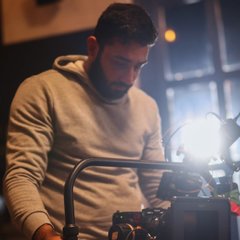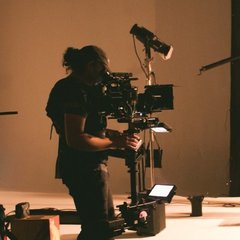
Bruce Alan Greene
Premium Members-
Posts
26 -
Joined
-
Last visited
Reputation
1 NeutralAbout Bruce Alan Greene

Contact Methods
-
Website
http://www.brucealangreene.com
Profile Information
-
Location
los angeles
Recent Profile Visitors
1,846 profile views
-
I use a fixed post all the time. But, all the components can slide up and down the post to change the CG. I do have a short post and a "super" post for special situations but very, very, rarely use them. My sled has no built-in wiring, so the posts are just hollow tubes, and there is a a wire bundle that runs through it.
-
Thanks Jens, I think I'll call Terry.
-
My J-Boxes are based on the PRO. My connecting cable is not. It's a 10 pin Lemo at each end and is not built into the sled. My center post is just that, a hollow tube. My connecting cable for video is coax connected to the big Lemo at each end. Inside the junction boxes, are not coax but very short cables from the BNC to the big Lemo.
-
Jarrett, I guess I'm a half knowledgable diy'er. I built the sled 16 years ago and did all of the soldering myself. I copied the PRO wiring diagrams as I had a big inventory of cables for film cameras all based on my old PRO sled. Are you saying that it's just the small 4pin Lemos (power and video) that are causing the issue? Since videotaps are pretty rare these days, I guess I could disconnect the video from these small Lemos and run BNC should a film shoot ever materialize. Is there an additional issue with the video connection to the main power/video lemo that goes to the green screen as well? Is there also an issue of how the video ground is wired in the old PRO design? I'm trying to remember if the power and video share the same ground...
-
And... who is David Hable? And where is he located?
-
Thanks Alec, I'm trying to remember how I wired this thing. My jboxes are connected by a large lemo, maybe 10 pins. A coax cable is wired to the big lemo and goes to the BNC plugs in the jboxes. But, as this is based on the old PRO, there are also connections to small lemo plugs and the main lemo to the PRO green screen plugs. It's possible that I could just disconnect the coax from the main power/video green screen connection and the mini 4pin lemos that we used in the old days to cinema video tap cameras. Do you think that would do the trick? I do have two sets of jboxes, so I guess I could experiment on one set and see how it goes. I can always just get power from the green screen lemo, and connect the green screen by BNC when called for.
-
I'm using a self built sled that I constructed during the analog days... My wiring is based on the PRO II I believe. My coax BNC connections work for analog, but not for digital signals like HDSDI. What do I need to change to enable digital over this cable? Is it about the ground connections? I'd like to add an HD screen for monitoring without running an external cable to the display. Thanks!
-
Thanks for the kind words Janice! My recent projects are unusual in that I've been working as the DP, "b" cam op, and .... colorist. When conforming the original shots to the edited reference movie I see every shot that's been repositioned. While the last couple projects I haven't operated steadicam myself, the previous two I was both DP and Steadicam op, which is really way too much to do at once! And, of course, when you do all these jobs yourself ... there is no one else to blame. Whatever it looks like, good or bad, I'm responsible. :) Links to a couple clip reels of my work as DP, Steadicam, and ... colorist (if anyone is interested:) http://www.brucealangreene.com/8-first-dates.html http://www.brucealangreene.com/love-in-the-big-city-3.html
-
On my last couple pictures, about 1/3 of the shots have been reframed in post. Almost always for the better :) Once in a while I'll even add post production stabilization to a shot if the imperfections are too distracting. Since I'm deeply involved in the post production of the films, I've seen all the "before's and "after"s so no need to watch the video assist split screened! -bruce alan greene cinematographer / Steadicam op
-
Airline media rate - ID solution
Bruce Alan Greene replied to Charles Papert's topic in Cases/Carts/Stands and Transport
I've created authentic cards in photoshop using a self portrait and bar code generated from some Internet site. Laminated at kinkos. Be sure to use the real company logo and contact info for your employer. They might try phoning them. Logo seems to be important as well. -
I am selling my back-up PRO green screen monitor. I believe it is the 2nd version, like the current model, but with the analog controls. It was used for about 1 year before becoming the back-up. I don't know the current value, though a new one sells for $16000 on the GPI website. I will consider any serious offer. Please respond by phone to 818-802-9252 or by e-mail to bruce@brucealangreene.com I am located in Los Angeles, California
-
Bruce, I'm glad you got you post to work, but I totally disagree with the idea that all telescoping posts inherently vibrate too much: it depends on the clamps, materials, diameters, etc. All of this was all worked out just fine about ten years ago, and is of course, a core feature of the Ultras, Clippers and various clones. Perhaps model III's and the like with thinner aluminum posts couldn't do it well enough, but not the modern carbon fiber ones. Telescoping posts also give you a full range of post lengths, from minimum length to six feet, and they extend or retract in seconds, require no extra parts, cases, etc. Jerry Can't argue with you Jerry, I'll just say that my design has some advantages, quickly changing to a super post isn't one of them:) -bruce
-
Eight years after I built my super-post I've used it on a shoot for the first time a couple weeks ago. I've always used another simpler way to get that low, or the ceiling was too low to use a long post, more often than not. I'm so thrilled that after the effort and expense (about $500) to build this thing that I've actually used it. Woo Hoo! My post is a simple 5' long carbon fiber pole that replaces the main pole. It also required building a long main power/video cable and an extra long monitor cable as well. The long cables double as emergency back ups for the regular length cables though. I was also pleased to see that the whole rig did not vibrate too much using the extra long pole. I think this is where not using telescoping posts is very helpful. And it worked well for chasing a small dog around a pet store, though we also did shots with a dolly, the Steadicam was better at making tight turns with the unpredictable animal. Installing the post took about 20 minutes and 2 people and a ladder. With practice, I think we could get that down to 10 minutes--but I don't think I'll be training for this...
-
I just received my equipment policy for renewal, and after reviewing the language in the policy I feel that I'm not necessarily covered when at work! Or basically when the equipment is not in my "custody and control" or something like that. And it's only covered to $5000 when rented out. It's not clear if rented out while I'm working on the show qualifies. It's all just so vague and I fear I might not be covered when it really matters such as when the production lets their own insurance lapse. So if anyone has a suggestion about where to buy insurance please let me know ASAP. Thanks so much! -bruce
-
Chris, I'm using the original PRO donkey box on my home-made sled. I did a lot of testing when building my sled to reduce this problem and I found the biggest contributor towards this shake is post length and resonance. I found the telescoping PRO post to be very problematic and my new sled now has a carbon fiber non-telescoping post. This has mostly eliminated this effect, but if I slide my batteries to the right position on my post I can induce harmonics that will find their way to the image (so I try to avoid that). I have also learned that a well cushioned shoe can make a very large improvement as well. Ultimately, all vibration begins in the foot and travels up the bones and into the sled. Unless your donkey box is very out of adjustment, I would look at the center post first to reduce the vibration. Keep it as short as possible as a rule of thumb. Also the f-900 is a very long camera with a high center of gravity. Make sure it is screwed down securely as well. Hope this helps some. I found that each time I eliminated some vibration, it would show up in another place. Even a very stiff sled will resonate at some frequency.




